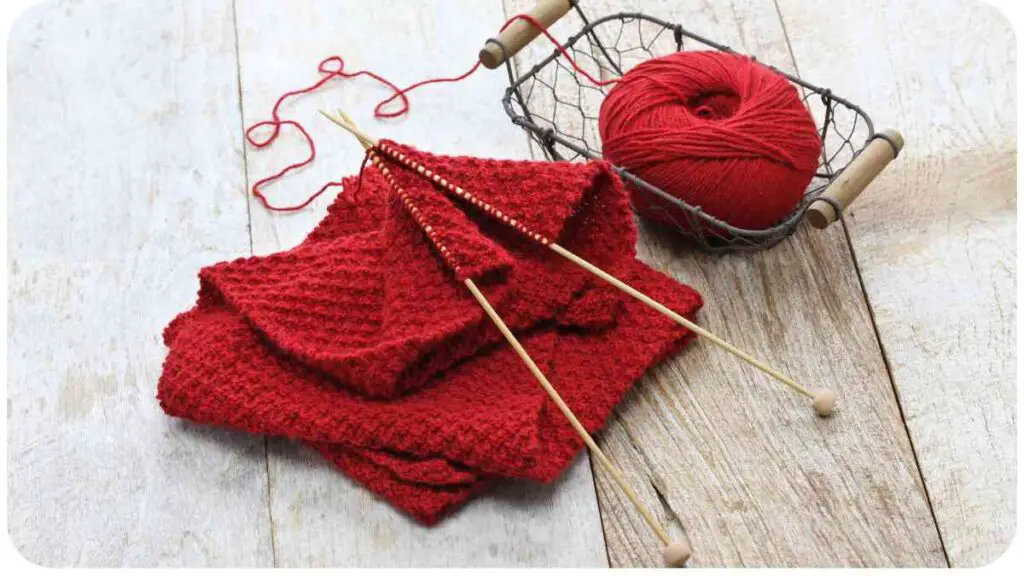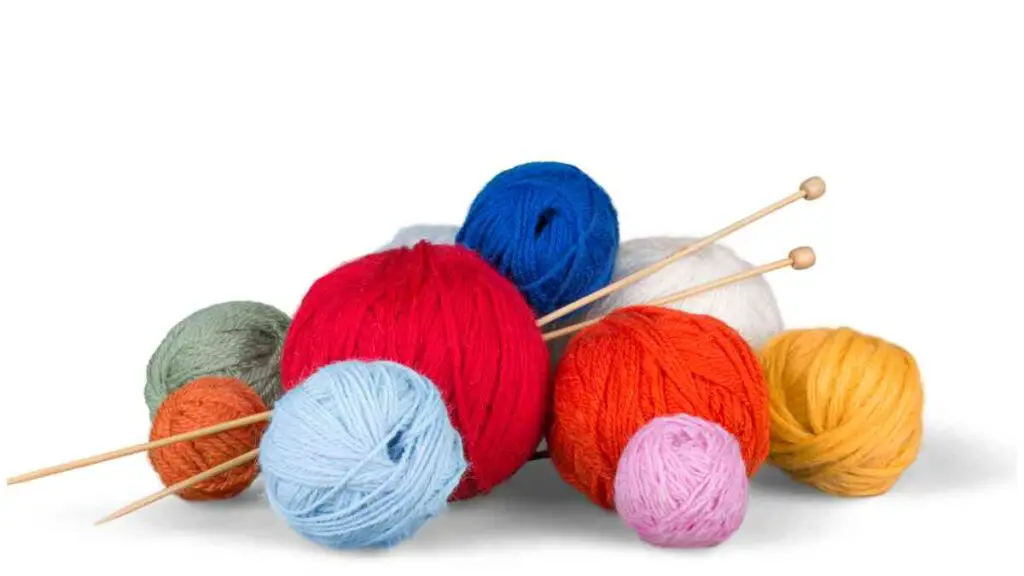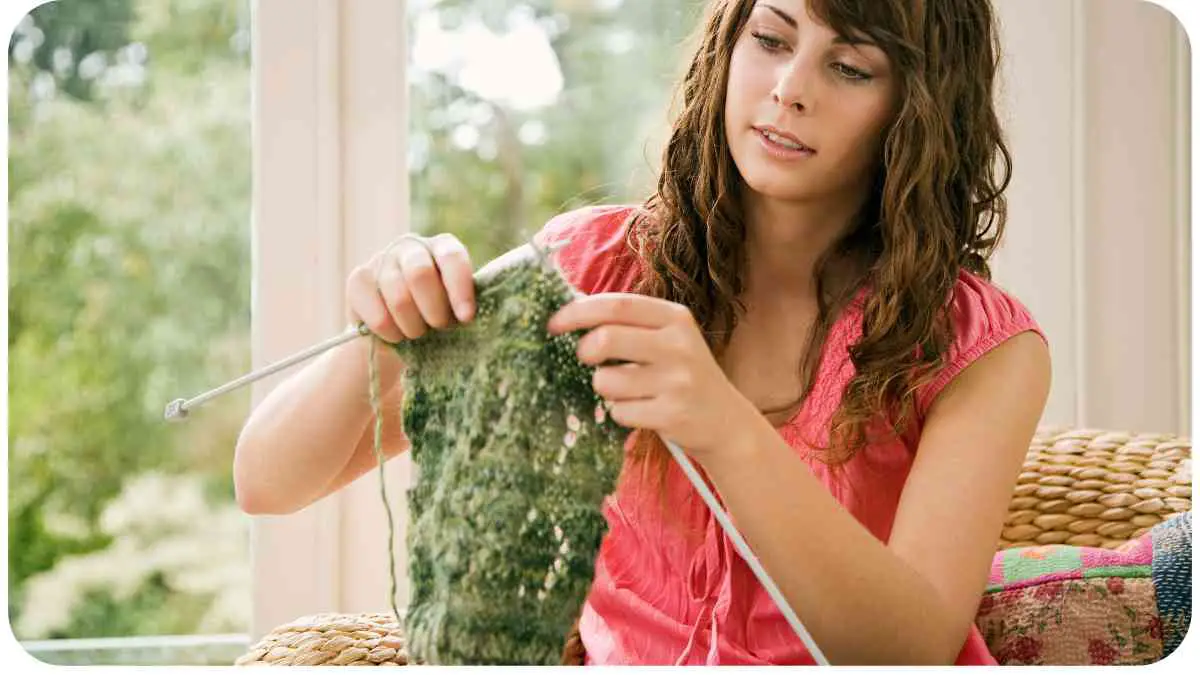Knitting scarves is a popular craft activity enjoyed by many. However, one common frustration that knitters often encounter is the curling of their finished scarves. Despite investing time and effort into creating a beautiful scarf, the curling edges can diminish its appeal.
In this article, we will explore the reasons behind this issue and provide troubleshooting tips to help you overcome it. By understanding the causes and implementing preventive measures, you’ll be able to create knitted scarves that lie flat and showcase your knitting prowess.
| Takeaway |
|---|
| Understanding the reasons behind curling in knitted scarves is crucial for troubleshooting and prevention. |
| Blocking your knitted scarf can help relax the stitches and flatten the fabric, reducing or eliminating curling. |
| Adjusting your tension and choosing the right yarn and needle combination can have a significant impact on preventing curling. |
| Certain stitch patterns, such as garter stitch and seed stitch, are less prone to curling and can be used to create curl-free scarves. |
| Taking preventive measures, such as proper yarn selection and incorporating edge stitches, can help minimize the chances of your scarf curling. |
| Seeking advice from fellow knitters and utilizing online resources can provide additional techniques and insights for preventing curling. |
2. Understanding Knitted Scarf Curling
Before we delve into the various troubleshooting tips, it’s essential to understand why knitted scarves tend to curl. The curling effect occurs due to the natural tendencies of certain stitches and yarns to contract or expand. As you knit, the edges may curl inward or outward, causing the scarf to no longer lay flat. Understanding the factors that contribute to this issue is crucial for effectively addressing it.
Addressing curling issues in crochet requires finesse. Learn to stop the curling with practical tips on tension, stitch choice, and blocking for a polished and flat finish.”
3. Common Causes of Knitted Scarf Curling

To successfully troubleshoot and fix the curling problem, it helps to identify the common causes. Here are a few factors that can contribute to knitted scarf curling:
- Stitch Selection: Some stitch patterns are naturally inclined to curl, especially those that create a ribbed or stockinette effect. These stitches have an unbalanced nature, causing the fabric to curl.
- Tension Issues: Uneven tension or tight stitches can lead to curling. If the tension is uneven, the fabric may pull in certain areas, resulting in curling.
- Yarn Choice: Certain yarns have a memory that causes them to curl. These yarns may include synthetic fibers or have a high percentage of acrylic content.
- Needle Type and Size: The type and size of needles used can also influence curling. Different needle materials and sizes yield varying results, affecting the final appearance of the scarf.
Now that we have identified the causes, let’s move on to the troubleshooting tips to help you address the curling issue in your knitted scarves.
4. Troubleshooting Tips for Knitted Scarf Curling
4.1 Blocking Your Knitted Scarf
Blocking is a technique used to shape and flatten knitted items. It involves wetting your scarf and carefully stretching it to desired dimensions. By blocking your knitted scarf, you can relax the stitches and reposition them, reducing or eliminating curling. Here’s how to do it:
- Soak your finished knitted scarf in lukewarm water for approximately 20 minutes.
- Gently squeeze out excess water without twisting or wringing.
- Lay the scarf on a clean towel and roll it up to absorb more moisture.
- Lay the moist scarf on a blocking board or a flat surface that allows you to pin it in shape.
- Start by pinning out the corners of the scarf, ensuring they lie flat and straight.
- Use rust-proof blocking pins to pin the edges of the scarf, gently stretching it to the desired width.
- Leave the scarf to dry completely before unpinning it.
Blocking can significantly reduce the curling effect, providing a remedy for scarves that tend to curl.
Knitting pitfalls? Navigate them skillfully with our comprehensive troubleshooting guide. From dropped stitches to uneven tension, find solutions to elevate your knitting journey.
4.2 Adjusting Your Tension
Tension plays a crucial role in how your finished scarf turns out. If your stitches are consistently tight or loose, it can lead to curling. Experiment with adjusting your tension and find what works best for the pattern and yarn you’re using. Practice knitting a swatch with different tension levels to determine the ideal tension for your project.
4.3 Choosing the Right Yarn and Needles

The type of yarn and needles used can have a remarkable impact on the curling of your knitted scarf. Consider the following tips:
- Opt for yarns that have less synthetic content and more natural fibers. Natural fibers tend to be less prone to curling.
- Choose needles that are appropriate for the yarn weight and stitch pattern you’re using. Smaller needles can help reduce curling in certain stitch patterns, while larger needles can create looser stitches that lay flatter.
To provide you with a better understanding, let’s take a look at a table comparing different yarn types and their curling tendencies:
| Yarn Type | Curling Tendency |
| 100% Acrylic | High |
| Acrylic Blend | Medium-High |
| Natural Fibers | Low-Medium |
| Wool Blend | Low |
The table above gives you an overview of different yarn types and their curling tendencies. By choosing the right yarn for your project, you can mitigate the curling effect and achieve better results.
Embark on a yarn exploration journey! Discover the nuances of choosing the best yarn for your knitting projects. From fiber considerations to weight, make informed decisions for stunning results.
4.4 Using Different Stitch Patterns
Certain stitch patterns are less prone to curling compared to others. Exploring different stitch patterns can provide a solution for your curling scarf. Consider incorporating the following stitch patterns into your project:
- Garter Stitch: This stitch pattern alternates between knit and purl rows, creating a textured fabric that lies flat.
- Seed Stitch: Seed stitch involves alternating knit and purl stitches within a row, resulting in a bumpy texture that resists curling.
- Basketweave Stitch: Basketweave stitch combines knit and purl stitches in alternating blocks, creating a structured pattern that prevents curling.
Experiment with different stitch patterns and see which ones work best for your scarf.
5. Prevention Techniques for Knitted Scarf Curling
While troubleshooting is essential, prevention is always better than cure. By implementing specific techniques during your knitting process, you can minimize the chances of your scarf curling. Let’s explore some preventive measures:
5.1 Proper Yarn Selection
Before you start knitting, carefully consider the type of yarn you’ll be using. Opt for yarns with less synthetic content and a higher proportion of natural fibers. Natural fibers like wool, cotton, or alpaca are less likely to curl compared to synthetic fibers like acrylic. Choosing the right yarn from the beginning can save you from potential curling issues later.
Unlock the secret to professional-looking knits by mastering the art of blocking. Learn why blocking is crucial, explore techniques, and elevate your finished projects to a new level of sophistication.
5.2 Testing Gauge and Tension
To ensure your scarf turns out the way you want, it’s crucial to test your gauge and tension before starting the project. Gauge refers to the number of stitches and rows per inch in your knitted fabric.
By knitting a gauge swatch using the intended yarn and needles, you can verify if your tension is consistent and if the gauge matches the pattern. Adjusting your tension and needle size based on the swatch results can help prevent curling caused by tension variations.
5.3 Incorporating Edge Stitches
Adding edge stitches to your scarf can help stabilize the edges and reduce curling. You can incorporate edge stitches like selvedge or slip stitches at the beginning and end of each row. These stitches create a more structured border that minimizes curling and gives a neater finish to your scarf. Experiment with different edge stitch techniques and find the one that works best for your project.
Tired of yarn chaos? Dive into effective strategies on preventing yarn tangling. From storage tricks to untangling methods, regain control over your yarn and enjoy a smoother crafting experience.
5.4 Blocking Techniques
As mentioned earlier, blocking is an effective technique for fixing curling issues in knitted scarves. However, blocking can also be used as a preventive measure. Once your scarf is complete, block it according to the instructions provided earlier. Blocking helps relax the stitches and ensures your scarf lays flat from the beginning.
6. Additional Tips and Tricks
Here are a few extra tips and tricks to help you achieve a beautiful, non-curling knitted scarf:
- Experiment with Blended Yarn: Blending natural fibers with synthetic fibers like acrylic can enhance the durability of your scarf, reducing the chances of curling.
- Embrace Ribbing: If you still enjoy ribbed patterns but want to minimize curling, consider adding ribbing to both edges of your scarf. This balances out the stitch pattern and prevents curling.
- Avoid Dense Stitch Patterns: Stitch patterns with a high stitch count per inch can contribute to curling. Opt for stitches with more breathable construction to maintain a flatter fabric.
- Ask for Advice: Reach out to fellow knitters, forums, or social media knitting communities for advice and specific tips based on your project. Exchanging knowledge and experiences can provide valuable insights.
7. Conclusion
In conclusion, curling is a common issue faced by knitters when creating scarves. However, armed with the troubleshooting tips and prevention techniques outlined in this article, you can overcome this challenge. Remember to choose yarns and stitch patterns wisely, adjust your tension accordingly, and incorporate blocking techniques for the best results.
By following these guidelines and applying the personal insights shared, you’ll be able to create beautifully knitted scarves that lay flat, showcase your expertise, and provide warmth and comfort to those who wear them. Happy
Further Reading
For more information on troubleshooting and preventing curling in knitted scarves, you may find the following resources helpful:
- Nimble Needles: How to Keep Knitting from Curling: This tutorial provides detailed instructions and techniques to prevent curling in your knitted projects, including scarves. It covers topics such as blocking, tension adjustment, and stitch pattern selection.
- WikiHow: Stop the Edges from Curling When Knitting a Scarf: This comprehensive step-by-step guide offers practical solutions to prevent curling in the edges of your knitted scarf. It includes tips on yarn selection, tension adjustments, and blocking methods.
- Don’t Be Such a Square: Prevent Curling: This blog post discusses the common causes of curling in knitted items and provides preventive measures to achieve a flat result. It explores different techniques and offers valuable insights to help you create curl-free scarves.
FAQs
Here are some frequently asked questions about preventing and troubleshooting curling in knitted scarves:
Q: How do I choose the right yarn to prevent curling?
A: Opt for yarns with a higher percentage of natural fibers like wool, cotton, or alpaca. These fibers have less memory than synthetic fibers like acrylic, reducing the chances of your scarf curling.
Q: Does blocking really help in preventing curling?
A: Yes, blocking can be highly effective in reducing or eliminating curling in your knitted scarf. It relaxes the stitches and allows the fabric to lay flat.
Q: Can adjusting the tension prevent curling in my scarves?
A: Yes, adjusting your tension can play a significant role in preventing curling. Experiment with different tension levels to find the sweet spot that produces a flat fabric.
Q: What stitch patterns are less prone to curling?
A: Stitch patterns like garter stitch, seed stitch, and basketweave stitch are known for their resistance to curling. Incorporating these stitch patterns in your scarf can help minimize or prevent curling.
Q: How can I incorporate edge stitches to prevent curling?
A: Adding edge stitches, such as selvedge or slip stitches, can help stabilize the edges of your scarf. These stitches create a structured border that resists curling and provides a neater finish to your project.
These FAQs address common concerns related to the curling of knitted scarves and provide valuable insights to help you overcome this issue.

My name is Hellen James, and I’m a crochet and knitting expert. I’ve been crocheting since I was just a kid, but I started taking it seriously when I realized that it was a great way to de-stress and relax. Now that I have kids of my own, I love teaching them how to do it too!

